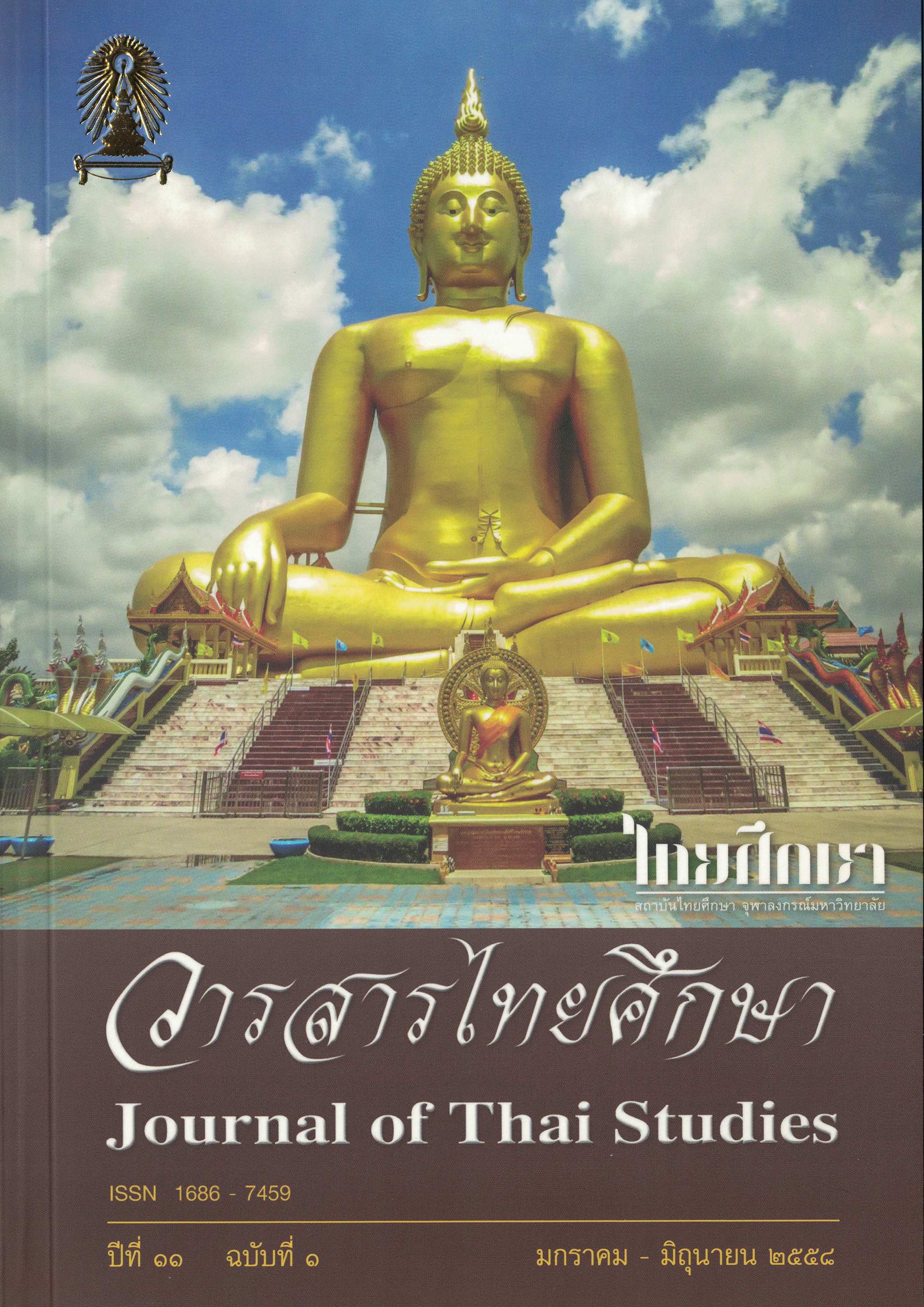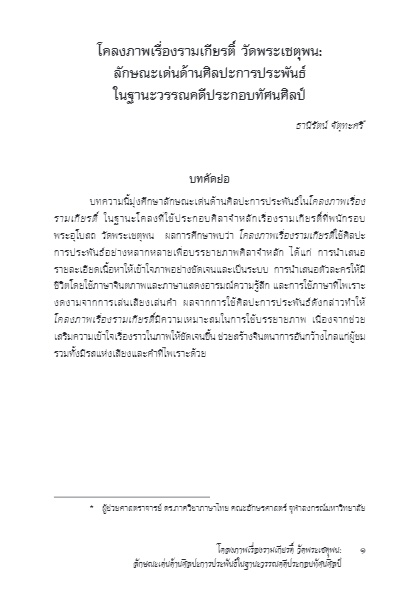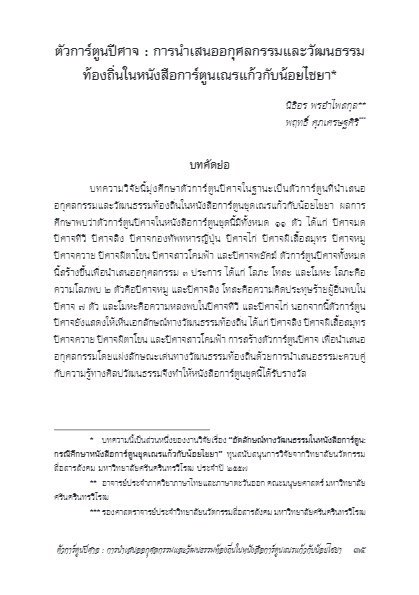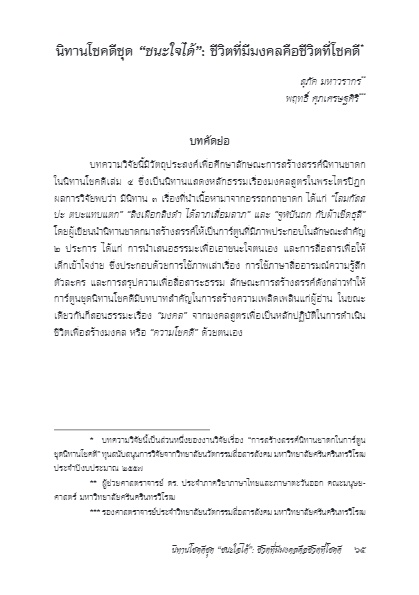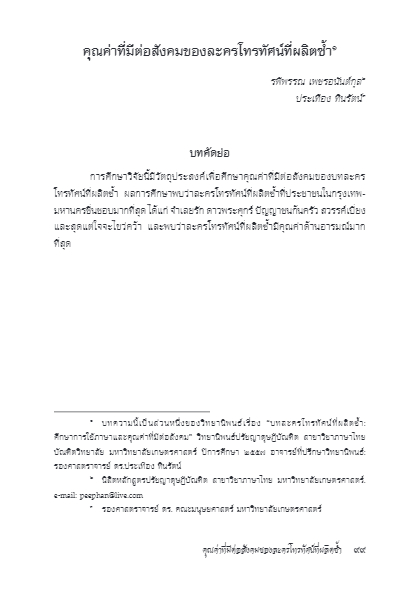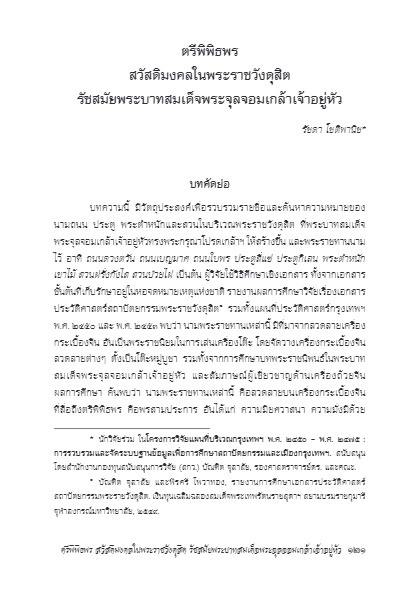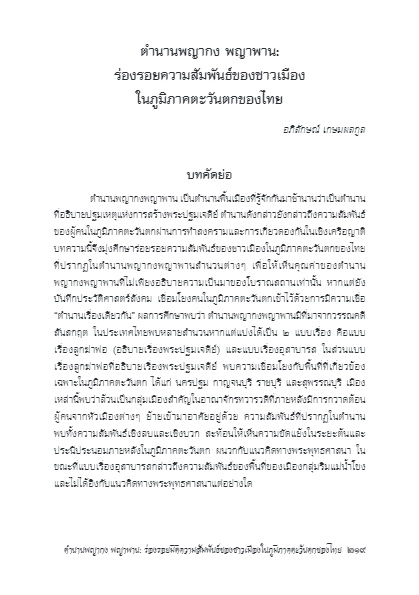วารสารไทยศึกษา - ปีที่ 11 ฉบับที่ 1
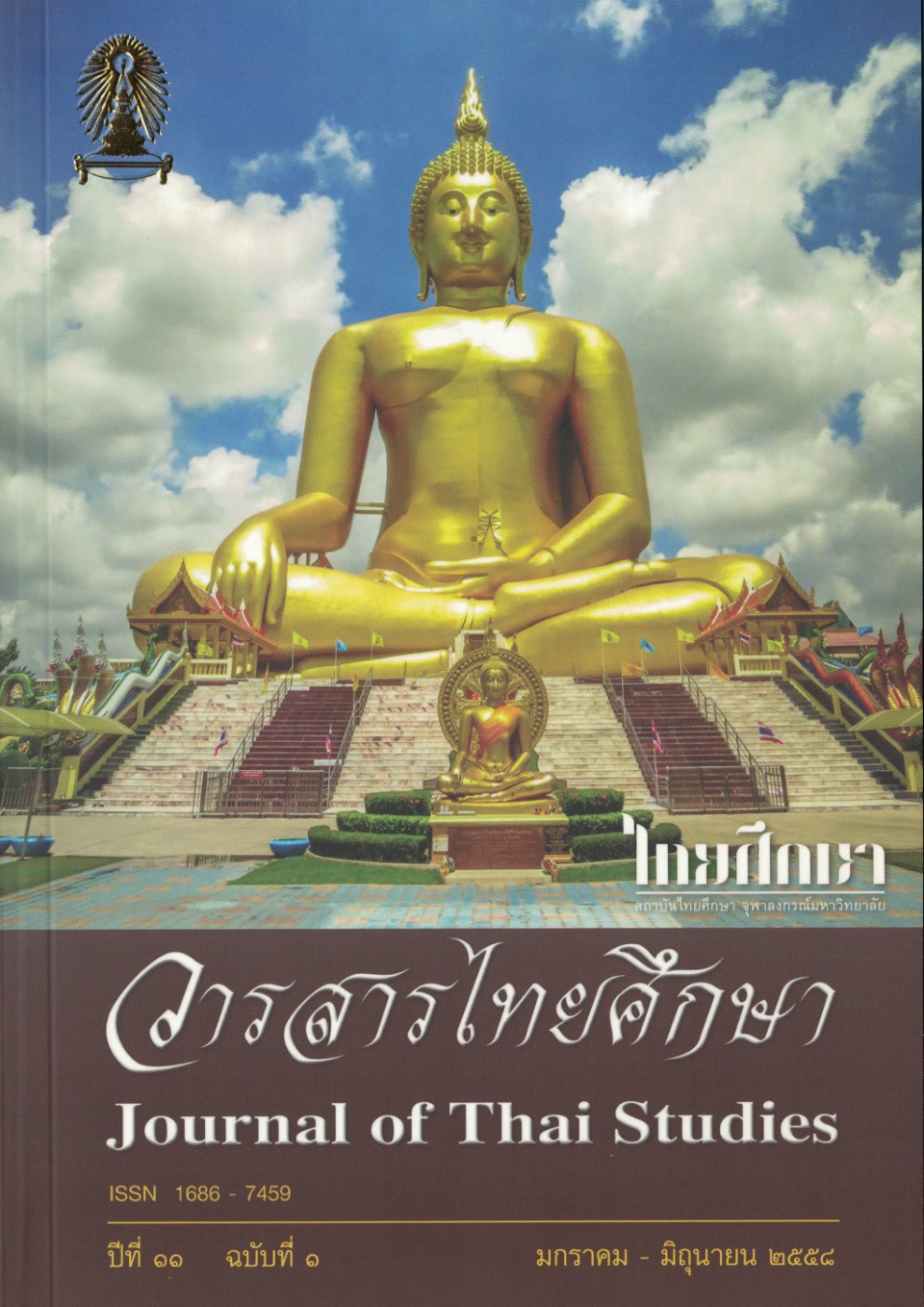
1) โคลงภาพเรื่องรามเกียรติ์ วัดพระเชตุพน : ลักษณะเด่นด้านศิลปะการประพันธ์ในฐานะวรรณคดีประกอบทัศนศิลป์ / ธานีรัตน์ จัตุทะศรี
2) ตัวการ์ตูนปีศาจ : การนำเสนออกุศลกรรมและวัฒนธรรมท้องถิ่นในหนังสือการ์ตูนเณรแก้วกับน้อยไชยา / นิธิอร พรอำไพสกุล, พฤทธิ์ ศุภเศรษฐศิริ
3) นิทานโชคดีชุด “ชนะใจได้” : ชีวิตที่มีมงคลคือชีวิตที่โชคดี / สุภัค มหาวรากร, พฤทธิ์ ศุภเศรษฐศิริ
4) คุณค่าที่มีต่อสังคมของละครโทรทัศน์ที่ผลิตซ้ำ / รวิพรรณ เพชรอนันต์กุล, ประเทือง ทินรัตน์
5) ตรีพิพิธพร สวัสดิมงคลในพระราชวังดุสิต รัชสมัยพระบาทสมเด็จพระจุลจอมเกล้าอยู่หัว / รัชดา โชติพานิช
6) งานช่างฝีมือกับเครื่องดนตรีไทยในสังคมไทยในสมัยรัตนโกสินทร์ / รุ่งอรุณ กุลธำรง
7) ตำนานพญากง พญาพาน : ร่องรอยความสัมพันธ์ของชาวเมืองในภูมิภาคตะวันตกของไทย / อภิลักษณ์ เกษมผลพูล
โคลงภาพเรื่องรามเกียรติ์ วัดพระเชตุพน : ลักษณะเด่นด้านศิลปะการประพันธ์ในฐานะวรรณคดีประกอบทัศนศิลป์
ธานีรัตน์ จัตุทะศรี
บทคัดย่อ
บทความนี้มุ่งศึกษาลักษณะเด่นด้านศิลปะการประพันธ์ในโคลงภาพเรื่องรามเกียรติ์ ในฐานะโคลงที่ใช้ประกอบศิลาจำหลักเรื่องรามเกียรติ์ที่พนักรอบพระอุโบสถ วัดพระเชตุพน ผลการศึกษาพบว่า โคลงภาพเรื่องรามเกียรติ์ใช้ศิลปะการประพันธ์อย่างหลากหลายเพื่อบรรยายภาพศิลาจำหลัก ได้แก่ การนำเสนอรายละเอียดเนื้อหาให้เข้าใจภาพอย่างชัดเจนและเป็นระบบ การนำเสนอตัวละครให้มีชีวิตโดยใช้ภาษาจินตภาพและภาษาแสดงอารมณ์ความรู้สึก และการใช้ภาษาที่ไพเราะงดงามจากการเล่นเสียงเล่นคำ ผลจากการใช้ศิลปะการประพันธ์ดังกล่าวทำให้โคลงภาพเรื่องรามเกียรติ์มีความเหมาะสมในการใช้บรรยายภาพ เนื่องจากช่วยเสริมความเข้าใจเรื่องราวในภาพให้ชัดเจนขึ้น ช่วยสร้างจินตนาการอันกว้างไกลแก่ผู้ชม รวมทั้งมีรสแห่งเสียงและคำที่ไพเราะด้วย
(ตีพิมพ์ใน วารสารไทยศึกษา ปีที่ 11 ฉบับที่ 1 (มกราคม – มิถุนายน 2558) หน้า 1-33)
Khlong Phab Rueng Ramakien at Phra Chetuphon Temple : Literary Techniques for Visual Art
Thaneerat Jatuthasri
Abstract
This paper aims to analyze the dominant literary techniques of Khlong Phab Rueng Ramakien, the verse describing of the Ramakien bas-reliefs, at Phra Chetuphon Temple. The study reveals that there are many literary techniques used in Khlong Phab Rueng Ramakien in order to describe the pictures of the bas-reliefs: presenting the details of the circumstances of the pictures concisely and systematically, characterizing the characters in the pictures to be lively by using the language of imagery as well as the language expressing emotion, and using the beautiful language by playing with the sounds in words. As a result, Khlong Phab Rueng Ramakien is suitable to convey the story in the pictures in which it enables readers to better understand the pictures, helps arousing imagination to visualize the pictures and contains literary beauty.
(Published in Journal of Thai Studies Volume 11 Number 1 (January – June 2015) Page 1-33)
บทความ / Full Text : Download
ตัวการ์ตูนปีศาจ : การนำเสนออกุศลกรรมและวัฒนธรรมท้องถิ่นในหนังสือการ์ตูนเณรแก้วกับน้อยไชยา
นิธิอร พรอำไพสกุล และ พฤทธิ์ ศุภเศรษฐศิริ
บทคัดย่อ
บทความวิจัยนี้มุ่งศึกษาตัวการ์ตูนปีศาจในฐานะเป็นตัวการ์ตูนที่นำเสนออกุศลกรรมและวัฒนธรรมท้องถิ่นในหนังสือการ์ตูนชุดเณรแก้วกับน้อยไชยา ผลการศึกษาพบว่าตัวการ์ตูนปีศาจในหนังสือการ์ตูนชุดนี้มีทั้งหมด 11 ตัว ได้แก่ ปีศาจมด ปีศาจทีวี ปีศาจลิง ปีศาจกองทัพทหารญี่ปุ่น ปีศาจไก่ ปีศาจผีเสื้อสมุทร ปีศาจหมู ปีศาจควาย ปีศาจผีตาโขน ปีศาจสาวโคมฟ้า และปีศาจพยัคฆ์ ตัวการ์ตูนปีศาจทั้งหมดนี้สร้างขึ้นเพื่อนำเสนออกุศลกรรม 3 ประการ ได้แก่ โลภะ โทสะ และโมหะ โลภะคือความโลภพบ 2 ตัวคือปีศาจหมู และปีศาจลิง โทสะคือความคิดประทุษร้ายผู้อื่นพบในปีศาจ 7 ตัว และโมหะคือความหลงพบในปีศาจทีวี และปีศาจไก่ นอกจากนี้ตัวการ์ตูนปีศาจยังแสดงให้เห็นเอกลักษณ์ทางวัฒนธรรมท้องถิ่น ได้แก่ ปีศาจลิง ปีศาจผีเสื้อสมุทร ปีศาจควาย ปีศาจผีตาโขน และปีศาจสาวโคมฟ้า การสร้างตัวการ์ตูนปีศาจ เพื่อนำเสนออกุศลกรรมโดยแฝงลักษณะเด่นทางวัฒนธรรมท้องถิ่นด้วยการนำเสนอธรรมะควบคู่กับความรู้ทางศิลปวัฒนธรรมจึงทำให้หนังสือการ์ตูนชุดนี้ได้รับรางวัล
(ตีพิมพ์ใน วารสารไทยศึกษา ปีที่ 11 ฉบับที่ 1 (มกราคม – มิถุนายน 2558) หน้า 35-64)
Monster: The Representation of Akusala-Kamma and Cultural in ‘Naen Kaew and Noi Chaiya’ Cartoon Book Series
Nition Pornumpaisakul and Prit Supasetsiri
Abstract
This research explores monster characters which are the representations of akusala-kamma and local and cultural identities in ‘Naen Kaew and Noi Chaiya’ cartoon book series. The results show that there are in total 11 types of monster, namely 1. ant, 2. TV monster, 3. monkey, 4. Japanese soldiers, 5. chicken, 6. sea monster, 7. pig, 8. buffalo, 9. ‘Phi-ta-khon’ ghost, 10. ‘sao khom fa’ ghost, and 11. tiger. Each of these monsters represents akusala-kamma — greed, hatred, and delusion. Greed is portrayed through pig and monkey monsters, hatred through 7 kinds of monster, and delusion (or lust) through TV and chicken monsters. Moreover, some monsters (monkey, sea, and buffalo monsters, and ‘ta-khon’ and ‘sao khom fa’ ghosts) are designed to depict local and cultural identities. All in all, with such distinct representation of akusala-kamma, Thai identities, and Dhamma, the series has been highly acclaimed and received many awards.
(Published in Journal of Thai Studies Volume 11 Number 1 (January – June 2015) Page 35-64)
บทความ / Full Text : Download
นิทานโชคดีชุด "ชนะใจได้" : ชีวิตที่มีมงคลคือชีวิตที่โชคดี
สุภัค มหาวรากร และ พฤทธิ์ ศุภเศรษฐศิริ
บทคัดย่อ
บทความวิจัยนี้มีวัตถุประสงค์เพื่อศึกษาลักษณะการสร้างสรรค์นิทานชาดกในนิทานโชคดีเล่ม 4 ซึ่งเป็นนิทานแสดงหลักธรรมเรื่องมงคลสูตรในพระไตรปิฎก ผลการวิจัยพบว่า มีนิทาน 3 เรื่องที่นำเนื้อหามาจากอรรถกถาชาดก ได้แก่ “โลมกัสสปะ ตบะแทบแตก” “ลิงเผือกลิงดำ ได้ลาภเสื่อมลาภ” และ “จูฬปันถก กับผ้าเช็ดธุลี” โดยผู้เขียนนำนิทานชาดกมาสร้างสรรค์ให้เป็นการ์ตูนที่มีภาพประกอบในลักษณะสำคัญ 2 ประการ ได้แก่ การนำเสนอธรรมะเพื่อเอาชนะใจตนเอง และการสื่อสารเพื่อให้เด็กเข้าใจง่าย ซึ่งประกอบด้วยการใช้ภาพเล่าเรื่อง การใช้ภาษาสื่ออารมณ์ความรู้สึกตัวละคร และการสรุปความเพื่อสื่อสาระธรรม ลักษณะการสร้างสรรค์ดังกล่าวทำให้การ์ตูนชุดนิทานโชคดีมีบทบาทสำคัญในการสร้างความเพลิดเพลินแก่ผู้อ่าน ในขณะเดียวกันก็สอนธรรมะเรื่อง “มงคล” จากมงคลสูตรเพื่อเป็นหลักปฏิบัติในการดำเนินชีวิตเพื่อสร้างมงคล หรือ “ความโชคดี” ด้วยตนเอง
(ตีพิมพ์ใน วารสารไทยศึกษา ปีที่ 11 ฉบับที่ 1 (มกราคม – มิถุนายน 2558) หน้า 65-98)
Win the Heart in Chokdee Tales Book Series : Life with Mangala is to Have a Lucky Life
Supak Mahavarakorn and Prit Supasetsiri
Abstract
This article aims to investigate the creation of Jataka tales in the forth book of Chokdee Tales series which portray the Dhamma about Mangala-Sutta in the Tipitaka. It has been found that there are 3 stories in the book that are based on Jataka-Atthakhata, namely Lomasakassapa the Hermit on the Verge of Losing Himself, The Change of Fortune of Black and Albino Monkeys, and Cullapanthaka and Dust Clothes. The creation of this illustrated book is distinguished by the use of various techniques to win your own theart. In addition, the stories can be easily comprehended by children because of illustrations and emotive language, and the author also provides summaries of the Dhamma for his readers. Not only has the series been widely enjoyed because of its creativity, but it has also taught the readers the Dhamma about Mangala-Sutta which inspires them to create their own luck.
(Published in Journal of Thai Studies Volume 11 Number 1 (January – June 2015) Page 65-98)
บทความ / Full Text : Download
คุณค่าที่มีต่อสังคมของละครโทรทัศน์ที่ผลิตซ้ำ
รวิพรรณ เพชรอนันต์กุล และ ประเทือง ทินรัตน์
บทคัดย่อ
การศึกษาวิจัยนี้มีวัตถุประสงค์เพื่อศึกษาคุณค่าที่มีต่อสังคมของบทละครโทรทัศน์ที่ผลิตซ้ำ ผลการศึกษาพบว่าละครโทรทัศน์ที่ผลิตซ้ำที่ประชาชนในกรุงเทพมหานครชื่นชอบมากที่สุด ได้แก่ จำเลยรัก ดาวพระศุกร์ ปัญญาชนก้นครัว สวรรค์เบี่ยง และสุดแต่ใจจะไขว่คว้า และพบว่าละครโทรทัศน์ที่ผลิตซ้ำมีคุณค่าด้านอารมณ์มากที่สุด
(ตีพิมพ์ใน วารสารไทยศึกษา ปีที่ 11 ฉบับที่ 1 (มกราคม – มิถุนายน 2558) หน้า 99-119)
The Value to Society of the TV Drama That Reproduces
Rapeephan Petchanankul and Pratuang Dinnaratana
Abstract
This research aimed to study the value to society of the TV dramas that were reproduced. The findings revealed that the reproduced TV dramas that the Bangkok people like most were: Cham Leuy Rak (Defendant of love), Daw Pra Sook (Venus), Panya Chon Kon Krua (Intellectual in the kitchen), Sawan Beang (Tilted paradise), and Sood Tae Chai Cha Kwai Kwa (As what the mind grasping for). And it was also found that emotional benefit is the grectest value of reproduced TV dramas
(Published in Journal of Thai Studies Volume 11 Number 1 (January – June 2015) Page 99-119)
บทความ / Full Text : Download
ตรีพิพิธพร สวัสดิมงคลในพระราชวังดุสิต รัชสมัยพระบาทสมเด็จพระจุลจอมเกล้าอยู่หัว
รัชดา โชติพานิช
บทคัดย่อ
บทความนี้ มีวัตถุประสงค์เพื่อรวบรวมรายชื่อและค้นหาความหมายของนามถนน ประตู พระตำหนักและสวนในบริเวณพระราชวังดุสิต ที่พระบาทสมเด็จพระจุลจอมเกล้าเจ้าอยู่หัวทรงพระกรุณาโปรดเกล้าฯ ให้สร้างขึ้น และพระราชทานนามไว้ อาทิ ถนนดวงตวัน ถนนเบญมาศ ถนนใบพร ประตูสี่แซ่ ประตูกิเลน พระตำหนักเขาไม้ สวนฝรั่งกังไส สวนบ๋วยไผ่ เป็นต้น ผู้วิจัยใช้วิธีศึกษาเชิงเอกสาร ทั้งจากเอกสารชั้นต้นที่เก็บรักษาอยู่ในหอจดหมายเหตุแห่งชาติ รายงานผลการศึกษาวิจัยเรื่องเอกสารประวัติศาสตร์สถาปัตยกรรมพระราชวังดุสิต รวมทั้งแผนที่ประวัติศาสตร์กรุงเทพฯ พ.ศ. 2450 และ พ.ศ.2453 พบว่า นามพระราชทานเหล่านี้ มีที่มาจากลวดลายเครื่องกระเบื้องจีน อันเป็นพระราชนิยมในการเล่นเครื่องโต๊ะ โดยจัดวางเครื่องกระเบื้องจีนลวดลายต่างๆ ตั้งเป็นโต๊ะหมู่บูชา รวมทั้งจากการศึกษาบทพระราชนิพนธ์ในพระบาทสมเด็จพระจุลจอมเกล้าเจ้าอยู่หัว และสัมภาษณ์ผู้เชี่ยวชาญด้านเครื่องถ้วยจีน ผลการศึกษา ค้นพบว่า นามพระราชทานเหล่านี้ คือลวดลายบนเครื่องกระเบื้องจีนที่สื่อถึงตรีพิพิธพร คือพรสามประการ อันได้แก่ ความมียศวาสนา ความมั่งมีด้วยโภคทรัพย์และบริวาร และความมีอายุมั่นขวัญยืน รวมทั้งลายที่มีความเป็นสวัสดิมงคลต่างๆ นับเป็นพรที่พระองค์พระราชทานให้แก่บ้านและเมืองเพื่อให้ผู้อยู่อาศัยมีความสุข ปัจจุบัน นามถนน ประตู ที่รัชกาลที่ 5 เคยพระราชทานไว้เปลี่ยนแปลงไป ความนิยมในการเล่นเครื่องโต๊ะก็ค่อยๆ เสื่อมสูญไป คงเหลือไว้เพียงข้อมูลทางประวัติศาสตร์ เอกสาร ภาพถ่ายและแผนที่บางส่วนเท่านั้น
(ตีพิมพ์ใน วารสารไทยศึกษา ปีที่ 11 ฉบับที่ 1 (มกราคม – มิถุนายน 2558) หน้า 121-164)
Prosperities Blessing in Dusit Palace During the Reign of King Chulalongkorn
Rachada Chotipanich
Abstract
This paper aims at collecting and studying the meaning of places’ names around Disit Palace: streets, gates, courts and gardens. Duangtawan Street, Benjamas Street, Baiporn Street, Sii Sae Gate, Kilen Gate, Khao Mai Court, Farang Kangsai Garden, Bui Pai Garden were built by King Chulalongkorn (Rama V). This paper is the documentary research which accumulate both primary and secondary source from National Thai Archive, the collection of report about the history and architect in Dusit Palace, and the map of Bangkok around 2450 – 2453 B.E. The research found that, the names given to the places in Dusit Palace are derived from Royal China Porcelain which was interested by King Rama V under the trend of arranging the Chinese altar. Together with studied King Rama V written works and interview with the expert in China Porcelain, also found that those names reflect to Tripittaporn or the three blessing: being powerful, being wealthy, and being healthy. That is to say, blessing for his Palace and Kingdom to success in those prosperity. Nowadays, the names given by King Rama V have declined together with the downfall of the popular of arranging Chinese altar. Thus these names remain only in recorded document.
(Published in Journal of Thai Studies Volume 11 Number 1 (January – June 2015) Page 121-164)
บทความ / Full Text : Download
งานช่างฝีมือกับเครื่องดนตรีไทยในสังคมไทยในสมัยรัตนโกสินทร์
รุ่งอรุณ กุลธำรง
บทคัดย่อ
บทความวิจัยงานช่างฝีมือกับเครื่องดนตรีไทยในสังคมไทยสมัยกรุงรัตนโกสินทร์ มีวัตถุประสงค์เพื่อศึกษาสมบัติงานช่างฝีมือประดิษฐ์เครื่องดนตรีไทยในสังคมไทยสมัยกรุงรัตนโกสินทร์ โดยวิธีวิจัยทางเอกสาร ผลการวิจัยพบว่า เครื่องดนตรีไทย ทั้งเครื่องดีด เครื่องสี เครื่องตี เครื่องเป่า เป็นสมบัติอันเกิดจากการบูรณาการความรู้งานช่างฝีมือ ได้แก่ งานช่างไม้ งานช่างกลึง งานช่างบุ งานช่างหล่อ งานช่างรัก งานช่างแกะ งานช่างสลัก งานช่างประดับมุกที่สืบทอดกันมาจากสมัยกรุงสุโขทัย จนถึงสมัยกรุงรัตนโกสินทร์ในรัชกาลปัจจุบัน และมีบทบาทสำคัญทางวัฒนธรรมในสังคมสมัยกรุงรัตนโกสินทร์คือ บทบาทของช่างชาววังมายังช่างชาวบ้าน บทบาทการบูรณาการองค์ความรู้งานช่างฝีมือประดิษฐ์เครื่องดนตรีไทย บทบาทของเครื่องดนตรีไทย บทบาทของบริบทในสังคมไทย ซึ่งทำให้งานช่างประดิษฐ์เครื่องดนตรีไทยสมัยกรุงรัตนโกสินทร์มีพัฒนาการจากรัชสมัยรัชกาลที่ 2 มาจนถึงรัชกาลปัจจุบัน บทบาทเหล่านี้จะเป็นพลังขับเคลื่อน ส่งเสริม สนับสนุน เกื้อกูลให้สังคมร่วมกันพัฒนาเครื่องดนตรีไทยยิ่งขึ้นในปัจจุบัน เพื่อเป็นสมบัติอันล้ำค่าทางวัฒนธรรมของสังคมไทย สังคมอาเซียน และสังคมโลกสืบไป
(ตีพิมพ์ใน วารสารไทยศึกษา ปีที่ 11 ฉบับที่ 1 (มกราคม – มิถุนายน 2558) หน้า 165-218)
Thai Arts and Crafts in Traditional Thai Musical Instruments During Rattanakosin Period
Rungaroon Kulthamrong
Abstract
This historical and documentary research article aims to study the inheritance of the traditional musical instruments in Thai society during Rattanakosin Period. The four fundamental types of Thai musical instruments are classified into four categories consisting of plucked instruments (lute), bowed string instruments, percussion instrument, and wind instrument. As an outstanding traditional treasures, these inventive instruments, have been creation of unique integrated craft works of woodcraftsman, turner, pad fitting, moulder, lacquer work, carver or sculpture, pearl artisan, and pearl marquetry. Since Sukothai period onwards to the present reign, the craft works in traditional Thai musical instrument has encompassed significantly the cultural role in Rattanakosin Period, notably, inheritance of craftwork of the royal Court to layman craftsmanship, knowledge integration of instrumental craftsman invention, role of Thai musical instruments, context of Thai society relating to Thai instrumental craftworks. Thai inventive musical-instrumental craftworks in Rattanakosin Period which were developed during the reign of King Rama the Second onwards, has become influential dynamic in supporting and promoting social cooperation for more creativity of Thai musical instruments in order to sustain the traditional treasure of Thai society including ASEAN and global communities.
(Published in Journal of Thai Studies Volume 11 Number 1 (January – June 2015) Page 165-218)
บทความ / Full Text : Download
ตำนานพญากง พญาพาน : ร่องรอยความสัมพันธ์ของชาวเมืองในภูมิภาคตะวันตกของไทย
อภิลักษณ์ เกษมผลพูล
บทคัดย่อ
ตำนานพญากงพญาพาน เป็นตำนานพื้นเมืองที่รู้จักกันมาช้านานว่าเป็นตำนานที่อธิบายปฐมเหตุแห่งการสร้างพระปฐมเจดีย์ ตำนานดังกล่าวยังกล่าวถึงความสัมพันธ์ของผู้คนในภูมิภาคตะวันตกผ่านการทำสงครามและการเกี่ยวดองกันในเชิงเครือญาติ บทความนี้จึงมุ่งศึกษาร่อยรอยความสัมพันธ์ของชาวเมืองในภูมิภาคตะวันตกของไทยที่ปรากฏในตำนานพญากงพญาพานสำนวนต่างๆ เพื่อให้เห็นคุณค่าของตำนานพญากงพญาพานที่ไม่เพียงอธิบายความเป็นมาของโบราณสถานเท่านั้น หากแต่ยังบันทึกประวัติศาสตร์สังคม เชื่อมโยงคนในภูมิภาคตะวันตกเข้าไว้ด้วยการมีความเชื่อ “ตำนานเรื่องเดียวกัน” ผลการศึกษาพบว่า ตำนานพญากงพญาพานมีที่มาจากวรรณคดีสันสกฤต ในประเทศไทยพบหลายสำนวนหากแต่แบ่งได้เป็น 2 แบบเรื่อง คือแบบเรื่องลูกฆ่าพ่อ (อธิบายเรื่องพระปฐมเจดีย์) และแบบเรื่องอุสาบารส ในส่วนแบบเรื่องลูกฆ่าพ่อที่อธิบายเรื่องพระปฐมเจดีย์ พบความเชื่อมโยงกับพื้นที่ที่เกี่ยวข้องเฉพาะในภูมิภาคตะวันตก ได้แก่ นครปฐม กาญจนบุรี ราชบุรี และสุพรรณบุรี เมืองเหล่านี้พบว่าล้วนเป็นกลุ่มเมืองสำคัญในอาณาจักรทวารวดีที่ภายหลังมีการกวาดต้อนผู้คนจากหัวเมืองต่างๆ ย้ายเข้ามาอาศัยอยู่ด้วย ความสัมพันธ์ที่ปรากฏในตำนานพบทั้งความสัมพันธ์เชิงลบและเชิงบวก สะท้อนให้เห็นความขัดแย้งในระยะต้นและประนีประนอมภายหลังในภูมิภาคตะวันตก ผนวกกับแนวคิดทางพระพุทธศาสนา ในขณะที่แบบเรื่องอุสาบารสกล่าวถึงความสัมพันธ์ของพื้นที่ของเมืองกลุ่มริมแม่น้ำโขงและไม่ได้อิงกับแนวคิดทางพระพุทธศาสนาแต่อย่างใด
(ตีพิมพ์ใน วารสารไทยศึกษา ปีที่ 11 ฉบับที่ 1 (มกราคม – มิถุนายน 2558) หน้า 219-256)
The Legend of Phya Kong and Phya Phan : A Trace of Relationship of People in Western Thailand
Aphilak Kasempholkoon
Abstract
The Legend of Phya Kong and Phya Phan is a local legend behind the creation of Phra Pathom Chedi. The legend says the relationships of people in the western region are formed through war and kindred families. This article aims to explore the traces of the relationships of people in the western Thailand in the various versions of Phya Kong and Phya Phan legend and to study the values of the this legend in recording history and connecting people in the western part of the country with the collective experience of having “the same legend”. The study found that the Phya Kong and Phya Phan legend derives from Sanskrit literature. In Thailand, several versions are found and can be divided into two storylines: one is a story about the killing of his father which explaines the archeological site of Phra Pathom Chedi; and the another is a story about Princess Usa and Prince Barot. The patricide storyline describes the establishment of Phra Pathom Chedi and the links to related areas, particularly in the western region, including Nakhon Pathom, Kanchanaburi, Ratchaburi and Suphan Buri. These cities are among the major cities in the Dvaravati period where people from other places were forced to settle in later. The relationships found in this legend are both negative and positive, reflecting the conflicts and subsequent compromises in the western region and are integrated with the Buddhist thoughts. The Princess Usa and Prince Barot tale discusses the relationship of the urban areas along the Mekong River and is not tied to any Buddhist concept.
(Published in Journal of Thai Studies Volume 11 Number 1 (January – June 2015) Page 219-256)
บทความ / Full Text : Download
